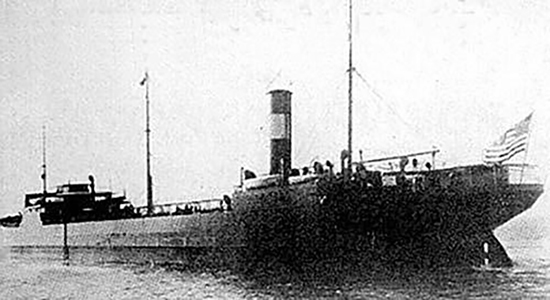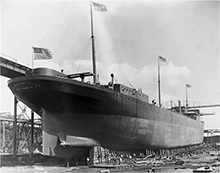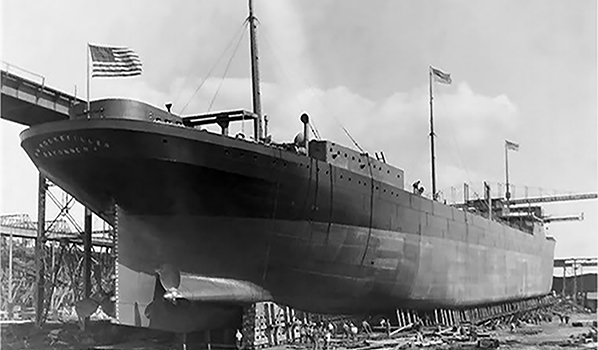William Rockefeller
Ship Stats
Location: Unknown
Depth: Unknown
Vessel Type: Tanker
Length: 554.0 feet Breadth: 75.0 feet
Gross Tonnage: 14,054 Cargo: 135,000 barrels of Bunker C fuel oil
Built: 1921, Newport News Shipbuilding, Newport News, Virginia, USA
Hull Number: 261 Port of Registry: Wilmington, Delaware, USA
Owner: Standard Oil Company of New Jersey, New York, USA
Lloyd's Register Details: Vessel had eight cargo tanks divided port and starboard by an oil-tight centerline bulkhead, Stream reciprocating engine/ 2 propellers/ 10 knots
Former Names: None
Date Lost: June 28, 1942
Sunk By: U-701 Survivors: 50 of 50 survived (0 dead)
Data Collected on Site: NOAA has collected historical data on the William Rockefeller, but the shipwreck site has not been located.
Significance: Casualty of World War II's Battle of the Atlantic
Wreck Site
The site of William Rockefeller has not been located in any official capacity. The location, according to reports, possibly suggests the vessel sank in deep water, making it difficult to locate.

Historical Background

By 1921, private shipping interests had been placing orders for bigger and better tankers on a steadily increasing scale. The Standard Oil Company of New Jersey, owner of the largest tanker fleet under private control at that time, further enlarged their fleet with the construction of eleven new tankers, including two of the largest tankers in the world in 1921, William Rockefeller and John D. Archbold. The tanker steamship, William Rockefeller, was the last in the series of tankers built for the Standard Oil Company, launching on October 21, 1921. The tanker went into service on November 10, 1921, and operated for nearly two decades transporting crude oil between Mexico and the eastern seaboard.
On June 27, 1942, William Rockefeller, carrying a cargo of 135,000 barrels of oil from Aruba bound for New York City, approached the North Carolina shoals and sought harbor in the protected anchorage of Ocracoke Inlet. Upon leaving the next morning, two Coast Guard cutters and three patrol planes escorted the tanker out of the inlet. Unbeknownst to Rockefeller, U-701 was patrolling around Cape Hatteras as it underwent some minor repairs. As the unsuspecting tanker approached Hatteras, U-701 reported hearing "heavy engine noise." U-701's captain raised the periscope and saw Rockefeller, the perfect prey.
It was midday on June 28, 1942, when U-701 fired two torpedoes at the approaching tanker. One torpedo hit the vessel amidships on the port side ripping a 20-foot hole in the side of the ship, spraying part of the tanker's cargo of oil over the back half of the ship. The pump room and the #5 tank instantly flooded, and fire spread across the ship. The crew panicked and abandoned ship without orders, and the captain joined the frightened crew in the lifeboats. As Rockefeller burned fiercely amidships, the captain noticed that the ship did not settle lower in the water, and it remained on a level keel; however, the men needed urgent medical attention. The U.S. Coast Guard vessel USS CG-470 rescued the entire crew of 50 and took them back to Ocracoke Harbor. After drifting for nearly 12 hours, the tanker sank.


